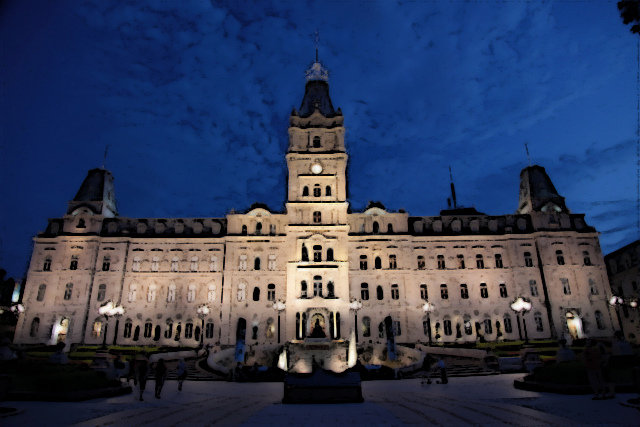Bâtiment du Parlement de Québec: Difference between revisions
No edit summary |
No edit summary |
||
| Line 3: | Line 3: | ||
<br> | <br> | ||
<br> | <br> | ||
== Introduction == | |||
The Parliament Building (French: Hôtel du Parlement) is an eight-floor building in Quebec City and home to the Parliament of Quebec, composed of the Lieutenant-Governor and the National Assembly. The building was designed by architect Eugène-Étienne Taché and was built from 1877 to 1886. With the frontal tower, the building stands at 52 metres or 171 feet in height. The building is located in Place de l'Assemblée nationale, atop Parliament Hill in the district of Vieux-Québec–Cap-Blanc–colline Parlementaire, just outside the walls of Old Quebec; this area is part of the borough of La Cité-Limoilou. | |||
== Architectural Style == | |||
It features the Second Empire architectural style that was popular for prestigious buildings both in Europe (especially France, where the style originated) and the United States during the latter 19th century. Although somewhat more sober in appearance and lacking a towering central belfry, Quebec City's Parliament Building bears a definite likeness to the Philadelphia City Hall, another Second Empire edifice in North America which was built during the same period. Even though the building's symmetrical layout with a frontal clock tower in the middle is typical of legislative institutions of British heritage, the architectural style is believed to be unique among parliament buildings found in other Canadian provincial capitals. Its facade presents a pantheon representing significant events and people of the history of Quebec. | |||
== Additional Buildings == | |||
* -- Édifice André-Laurendeau was added from 1935 to 1937 to house the Ministry of Transport. | |||
* -- Édifice Honoré-Mercier was added from 1922 to 1925 to house the Ministries of the Treasury (Finances), the Attorney General, and the Secretary General of the National Assembly. | |||
* -- Édifice Jean-Antoine-Panet was added from 1931 to 1932 for the Ministry of Agriculture. | |||
* -- Édifice Pamphile-Le May added from 1910 to 1915 for the Library of the National Assembly, various other government offices and the Executive Council. | |||
Latest revision as of 11:29, 28 April 2015
Introduction
The Parliament Building (French: Hôtel du Parlement) is an eight-floor building in Quebec City and home to the Parliament of Quebec, composed of the Lieutenant-Governor and the National Assembly. The building was designed by architect Eugène-Étienne Taché and was built from 1877 to 1886. With the frontal tower, the building stands at 52 metres or 171 feet in height. The building is located in Place de l'Assemblée nationale, atop Parliament Hill in the district of Vieux-Québec–Cap-Blanc–colline Parlementaire, just outside the walls of Old Quebec; this area is part of the borough of La Cité-Limoilou.
Architectural Style
It features the Second Empire architectural style that was popular for prestigious buildings both in Europe (especially France, where the style originated) and the United States during the latter 19th century. Although somewhat more sober in appearance and lacking a towering central belfry, Quebec City's Parliament Building bears a definite likeness to the Philadelphia City Hall, another Second Empire edifice in North America which was built during the same period. Even though the building's symmetrical layout with a frontal clock tower in the middle is typical of legislative institutions of British heritage, the architectural style is believed to be unique among parliament buildings found in other Canadian provincial capitals. Its facade presents a pantheon representing significant events and people of the history of Quebec.
Additional Buildings
- -- Édifice André-Laurendeau was added from 1935 to 1937 to house the Ministry of Transport.
- -- Édifice Honoré-Mercier was added from 1922 to 1925 to house the Ministries of the Treasury (Finances), the Attorney General, and the Secretary General of the National Assembly.
- -- Édifice Jean-Antoine-Panet was added from 1931 to 1932 for the Ministry of Agriculture.
- -- Édifice Pamphile-Le May added from 1910 to 1915 for the Library of the National Assembly, various other government offices and the Executive Council.
